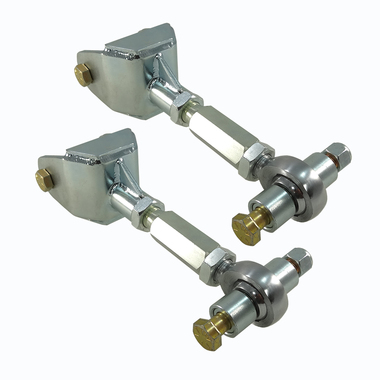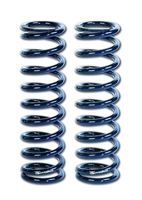Setting Up the Front Suspension on Fox and SN-95 Mustangs

The Fox and SN95 Mustangs are a great platform for making big power, but what about handling? The components used in the MacPherson strut suspension on the front of the car aren’t up to modern standards, but the basic design lends itself to modification, allowing for massive improvements in handling with a few performance parts.
Camber Caster Plates
The Fox body and SN95 shock towers don’t have camber or caster adjustment, which can cause problems with tire wear and can lead to serious alignment problems when making modifications to the suspension.
Camber is the angle of the wheel from the inside of the rim to the outside. If the car is lowered, the shorter distance between the A arm and shock tower causes the steering knuckle to tilt inward, causing excess negative camber that reduces grip and traction.
Caster is the wheel’s angle of motion when compressed. If the caster is neutral, the wheel will move straight up, keeping the tires flat on the ground when going through turns. If the caster is negative or positive, the wheel will move forward or backward as the weight of the vehicle moves side to side through turns. A little positive caster, which will cause the wheel to move forward slightly when hitting a bump, can add high speed stability. As with camber, suspension modifications can throw off the camber significantly, causing handling problems.
Camber caster plates replace the stock mount points with long slots for the strut bolts, allowing their position to be altered side-to-side and front-to-back to dial in the alignment. These plates are necessary if you’re lowering the car or switching to coilovers, but even if you decide to keep the suspension mostly stock, the added adjustability can improve handling and reduce tire wear.
K-Member
Aftermarket k-members are usually thought of as a way to support different engines, but these are also an important component when improving your Mustang’s suspension. The stock unit isn’t just heavy, it also flexes easily, altering the suspension geometry.
Some K-members are designed to improve handling by moving the wheel position forward, effectively shifting the vehicle’s weight balance. While it does help, this shift requires a lot of modifications to work properly from altering the fenders to modifying the suspension. K-members from UPR Products keep the same wheelbase, greatly simplifying installation while improving handling and lowering front end weight.
A Arms
The stock A arms are made out of stamped steel, which, like the K-Member, makes them heavy and weak. Tubular steel arms reduce flex significantly while reducing unsprung weight, helping the suspension react to bumps for improved traction and ride quality. UPR makes stock-size replacements as well as short A arms that maintain wheel position when using wide aftermarket brake kits.
Coilovers
A coilover mounts the spring on the shock. By using this design, manufacturers are able to shorten the length of the shock and create an adjustable spring mount, allowing the ride height to be dialed in for a specific application. Many aftermarket A arms eliminate the spring perch, requiring the use of coilovers.
Springs

The springs absorb and release energy as the wheels move over bumps while supporting the chassis on the suspension. Switching to a shorter spring set will lower the vehicle, and in turn lower the center of gravity for better handling. A stiffer spring will flex less, keeping the tire against the ground for better handling at the expense of ride quality. To get the right trade-off between ride and handling, Strange Engineering makes springs for their coilover kit rated between from 95 to 150 lbs.
Struts
The Mustang uses a MacPherson strut suspension, but unlike most designs, the spring is on a separate perch instead of being mounted over the shock. The shock works with the spring, controlling how quickly the suspension moves, both when moving up (compression) when hitting a bump, then back down (rebound.) Adjustable shocks have a valve that can be altered to change how quickly fluid moves inside, altering compression and rebound. Single adjustable struts control both motions using one knob, but changing the setting mostly alters compression. Dual adjustable struts like AFCO’s Big Gun allow compression and rebound separately.
Want to Improve Your Mustang’s Suspension? Talk to the Experts
Anderson Ford Motorsport has helped its customers build Mustangs for street, strip and racetrack applications for over 30 years, so we know what works. We have everything you need for your build, whether you want something that’s better on the street or a setup that can handle a day of club racing.
Recent Posts
-
Bringing the Fox Body Mustang into the 21st Century with Holley Terminator X
Anderson Ford Motorsport has been in the Fox Mustang performance industry since 1989. One of the bi …22nd Oct 2021 -
Roush Supercharger install on a 2019 Ford Mustang
Check out this 2019 Ford Mustang before and after we installed a Roush Supercharger. …21st Feb 2020 -
All Blower Installations are not Equal.
Why Should You Choose a Company to Install Your Blower That Has a Dyno Facility In-House?Are all de …24th Jan 2020

